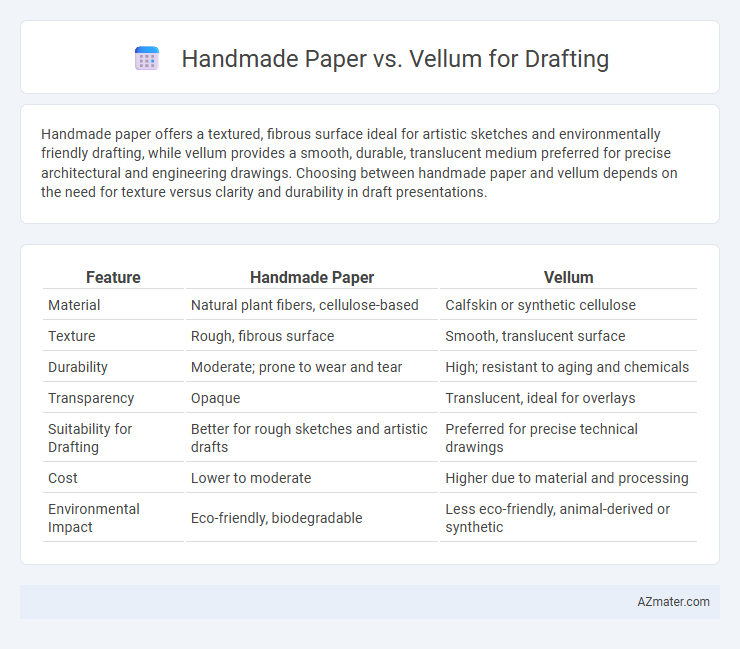Handmade paper offers a textured, fibrous surface ideal for artistic sketches and environmentally friendly drafting, while vellum provides a smooth, durable, translucent medium preferred for precise architectural and engineering drawings. Choosing between handmade paper and vellum depends on the need for texture versus clarity and durability in draft presentations.
Table of Comparison
| Feature | Handmade Paper | Vellum |
|---|---|---|
| Material | Natural plant fibers, cellulose-based | Calfskin or synthetic cellulose |
| Texture | Rough, fibrous surface | Smooth, translucent surface |
| Durability | Moderate; prone to wear and tear | High; resistant to aging and chemicals |
| Transparency | Opaque | Translucent, ideal for overlays |
| Suitability for Drafting | Better for rough sketches and artistic drafts | Preferred for precise technical drawings |
| Cost | Lower to moderate | Higher due to material and processing |
| Environmental Impact | Eco-friendly, biodegradable | Less eco-friendly, animal-derived or synthetic |
Introduction: Comparing Handmade Paper and Vellum for Drafting
Handmade paper offers a textured, organic surface ideal for artistic and traditional drafting techniques, promoting ink absorption and unique visual effects. Vellum provides a smooth, durable, and translucent medium favored for precise architectural and engineering drafts, allowing for easy corrections and overlays. Choosing between handmade paper and vellum depends on the drafting project's need for texture, transparency, and precision.
Material Composition: What Sets Handmade Paper Apart from Vellum
Handmade paper is crafted from natural fibers such as cotton, hemp, or recycled materials, offering a textured, absorbent surface ideal for traditional drafting techniques. Vellum, made from cellulose acetate or polyester, provides a smooth, translucent finish that enhances precision and durability in technical drawings. The intrinsic fiber composition of handmade paper allows for superior ink absorption and unique tactile qualities, distinguishing it from the synthetic, stable structure of vellum favored in modern drafting.
Surface Texture and Finish: Drafting Experience Differences
Handmade paper features a rough, fibrous surface texture that provides tactile resistance, enhancing pencil grip and control but potentially causing uneven lines during detailed drafting. Vellum offers a smooth, translucent finish that allows for precise, clean line work and easy erasing, ideal for technical drawings and overlays. The drafting experience on handmade paper feels organic and textured, while vellum delivers a sleek, consistent surface for accuracy and clarity.
Durability and Longevity in Drafting Applications
Handmade paper offers moderate durability for drafting, often favored for its texture and archival qualities, but it is more susceptible to wear and environmental damage over time. Vellum, crafted from animal skin or synthetic materials, provides superior durability and longevity, resisting tearing, moisture, and fading, making it ideal for precise technical drawings and long-term preservation. In drafting applications, vellum's strength and stability ensure that critical details remain intact, while handmade paper may require careful handling to maintain its integrity.
Ink Absorption and Line Sharpness: Performance Analysis
Handmade paper exhibits high ink absorption, resulting in rich, textured lines but can cause slight feathering and less precision in line sharpness. Vellum offers superior ink repellency and a smooth surface, ensuring crisp, clean lines with minimal bleeding, ideal for detailed drafting work. The choice between handmade paper and vellum depends on whether the priority is artistic texture or technical accuracy in ink performance.
Transparency: Tracing and Overlay Capabilities
Handmade paper offers moderate transparency suitable for basic tracing and overlay work but often exhibits uneven texture, which can affect precision in detailed drafting tasks. Vellum, prized for its smooth surface and high translucency, provides superior clarity and consistent light transmission, making it ideal for precise tracing and multiple overlay layers in architectural and engineering drawings. Choosing vellum ensures enhanced visibility and accuracy for intricate design work requiring detailed line replication.
Erasability and Correction Ease
Handmade paper offers a textured surface that can absorb ink more readily, making erasability and correction more challenging compared to vellum. Vellum, with its smoother and less porous finish, allows for cleaner erasures and easier corrections using drafting pencils or technical pens. Professionals often prefer vellum for precise drafting due to its superior resistance to smudging and ease of modification.
Environmental Impact and Sustainability Factors
Handmade paper for drafting is often praised for its eco-friendly production methods, utilizing recycled fibers and requiring less energy compared to vellum, which is typically derived from animal skins or synthetic materials with higher environmental footprints. Sustainable sourcing and biodegradability of handmade paper contribute to reduced waste and lower carbon emissions in the drafting process. Vellum, while durable and precise, poses sustainability challenges due to resource-intensive manufacturing and limited recyclability, making handmade paper a more environmentally responsible choice for drafting applications.
Cost Considerations: Budgeting for Drafting Materials
Handmade paper typically costs more due to labor-intensive production and limited availability, making it less suitable for tight budgets in drafting projects. Vellum, especially synthetic or plastic variants, offers a more affordable and consistent option favored by architects and engineers prioritizing cost efficiency. Budgeting for drafting materials should account for the frequency of use, durability, and the specific requirements of the project to balance between the premium quality of handmade paper and the economic practicality of vellum.
Choosing the Right Medium: Handmade Paper vs Vellum for Your Project
Handmade paper offers a unique texture and absorbency ideal for projects requiring a tactile, organic feel, while vellum provides a smooth, translucent surface perfect for precision drafting and overlays. Choosing between handmade paper and vellum depends on the project's needs for durability, detail clarity, and desired aesthetic effects. For intricate architectural designs or technical drawings, vellum's stability and translucency ensure accuracy, whereas handmade paper suits artistic or textured presentations.

Infographic: Handmade paper vs Vellum for Drafting
 azmater.com
azmater.com